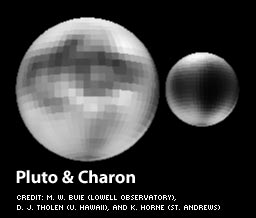Wire Maze Electricity DIY STEM Kit
$9.99$5
 Aside from being, on average, the farthest planet from the Sun, Pluto and its orbit have several characteristics that make it unique. Its greater distance means its orbital period of 248 years is the longest of all planets. Its orbit has the highest eccentricity, which means that its distance from the Sun varies more than other planets. Its orbit is so far from circular that it can actually be closer to the Sun than Neptune at times.
The plane of Pluto's orbit is also tilted the most compared to the rest, taking it further north and south of the Earth's orbital plane than the other planets.
Pluto's only know satellite, Charon, is the largest satellite compared to the size of its mother planet. The Earth's moon held that title until Charon was discovered in 1978. Charon's large mass relative to Pluto means that the center of their common orbit about each other lies outside Pluto's surface, another unique characteristic of this Planet.
Finally, Pluto itself is unique for its position and physical characteristics. The four inner planets--Mercury, Venus, Earth and Mars--are known as terrestrial planets for their smaller size, solid surface, and similarity to Earth. The next four planets, looking outward from the Sun, are gas giants. They are larger than the terrestrial planets, have a larger number of satellites, and no solid surface. Beyond the gas giants, Pluto breaks the pattern by once again showing characteristics more like a terrestrial planet--small, solid surface, and only one (known) satellite.
Because of its peculiarities, many have suggested that Pluto should not really be considered a planet--that it had a different origin and is more closely related to a comet or asteroid.
Aside from being, on average, the farthest planet from the Sun, Pluto and its orbit have several characteristics that make it unique. Its greater distance means its orbital period of 248 years is the longest of all planets. Its orbit has the highest eccentricity, which means that its distance from the Sun varies more than other planets. Its orbit is so far from circular that it can actually be closer to the Sun than Neptune at times.
The plane of Pluto's orbit is also tilted the most compared to the rest, taking it further north and south of the Earth's orbital plane than the other planets.
Pluto's only know satellite, Charon, is the largest satellite compared to the size of its mother planet. The Earth's moon held that title until Charon was discovered in 1978. Charon's large mass relative to Pluto means that the center of their common orbit about each other lies outside Pluto's surface, another unique characteristic of this Planet.
Finally, Pluto itself is unique for its position and physical characteristics. The four inner planets--Mercury, Venus, Earth and Mars--are known as terrestrial planets for their smaller size, solid surface, and similarity to Earth. The next four planets, looking outward from the Sun, are gas giants. They are larger than the terrestrial planets, have a larger number of satellites, and no solid surface. Beyond the gas giants, Pluto breaks the pattern by once again showing characteristics more like a terrestrial planet--small, solid surface, and only one (known) satellite.
Because of its peculiarities, many have suggested that Pluto should not really be considered a planet--that it had a different origin and is more closely related to a comet or asteroid.
 'Never regard study as a duty, but as the enviable opportunity to learn to know the liberating influence of beauty in the realm of the spirit for your own personal joy and to the profit of the community to which your later work belongs.'
'Never regard study as a duty, but as the enviable opportunity to learn to know the liberating influence of beauty in the realm of the spirit for your own personal joy and to the profit of the community to which your later work belongs.'